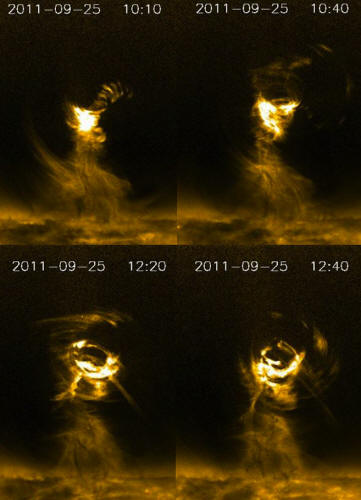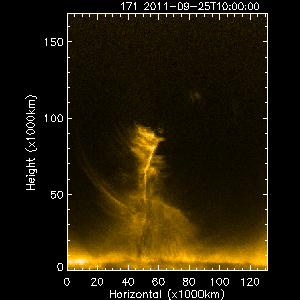|

by Adam Mann
March 28, 2012
from
Wired Website

Huge
solar tornado discovered
The superb spatial and temporal resolution
of Solar Dynamic Observatory (SDO) allows us
to observe the solar atmosphere in great
detail.
Using
the Atmospheric Imaging Assembly (AIA) on
board SDO, we are able to find spectacular
rotation of material at solar prominences
and the coronal cavities above them.
Quite
often, big coronal mass ejections will occur
after these rotations are observed.
The
image and animated movie (below) shown here
are for a spectacular event observed on Sept
25 2011 and a study of this event will be
presented in the National Astronomy Meeting
2012 and submitted for publication in the
Astrophysical Journal by us (Dr. Xing Li,
Dr. Huw Morgan and Mr. Drew Leonard).
The
tornado can be as wide as five earths.
Source
This enormous tornado erupting from the surface of the sun is big
enough to swallow the Earth. In fact, it could swallow five Earths.
Discovered using NASAís
Solar Dynamic Observatory satellite, this
colossal twisting mass is made up of superheated gas at a
temperature of between 90,000 and 3.6 million degrees Fahrenheit.
Over the course of three hours, this behemoth reached up from the
sunís surface to a height of 125,000 miles, or roughly half the
distance between the Earth and the moon. The hot gases were whipped
up to nearly 186,000 miles per hour. In comparison, the wind speed
of terrestrial tornadoes generally reaches a paltry 100 miles per
hour.
Scientists have previously seen smaller solar tornadoes with other
sun-observing satellites but this one - spotted in September 2011 -
is thought to be the first one ever filmed:

Since then,
researchers have seen at least one more solar tornado, an
Earth-sized twister seen in the video below.
These tornadoes often precede events known as coronal mass ejections
- huge eruptions of charged particles that blast out of the sunís
surface with tremendous energy.
Such flare-ups are thought to be
related to interactions among the sunís magnetic field lines, whose
corkscrewing movements also shape the solar tornado.
For a 30
hour spell (Feb 7-8, 2012) the Solar Dynamics
Observatory captured plasma caught in a magnetic
dance across the Sun's surface.
The results
closely resemble extreme tornadic activity on
Earth.
|


